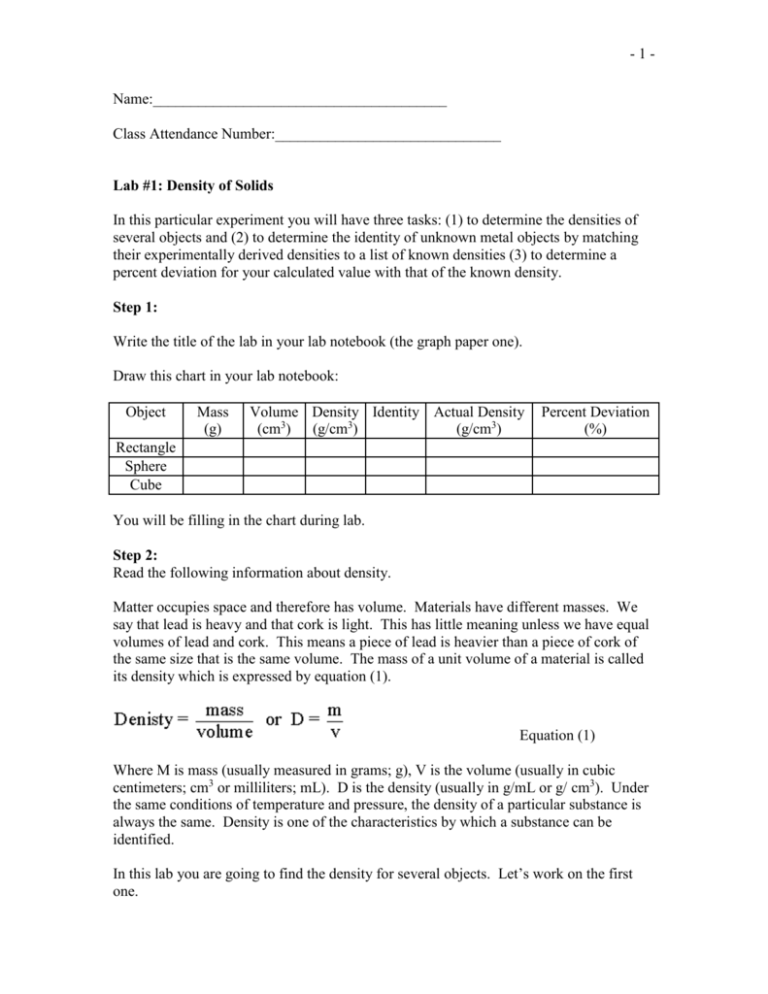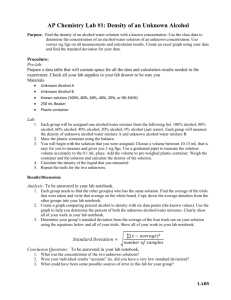Lab #1: Density of Solids
advertisement

-1Name:_______________________________________ Class Attendance Number:______________________________ Lab #1: Density of Solids In this particular experiment you will have three tasks: (1) to determine the densities of several objects and (2) to determine the identity of unknown metal objects by matching their experimentally derived densities to a list of known densities (3) to determine a percent deviation for your calculated value with that of the known density. Step 1: Write the title of the lab in your lab notebook (the graph paper one). Draw this chart in your lab notebook: Object Mass (g) Volume Density Identity Actual Density (cm3) (g/cm3) (g/cm3) Percent Deviation (%) Rectangle Sphere Cube You will be filling in the chart during lab. Step 2: Read the following information about density. Matter occupies space and therefore has volume. Materials have different masses. We say that lead is heavy and that cork is light. This has little meaning unless we have equal volumes of lead and cork. This means a piece of lead is heavier than a piece of cork of the same size that is the same volume. The mass of a unit volume of a material is called its density which is expressed by equation (1). Equation (1) Where M is mass (usually measured in grams; g), V is the volume (usually in cubic centimeters; cm3 or milliliters; mL). D is the density (usually in g/mL or g/ cm3). Under the same conditions of temperature and pressure, the density of a particular substance is always the same. Density is one of the characteristics by which a substance can be identified. In this lab you are going to find the density for several objects. Let’s work on the first one. -2Step 3: Read the following scale to determine the mass of a rectangle: Write this number in the mass box for the rectangle in your lab notebook. To calculate volume by calculation, measure the object (or use given measurements) and use the formula for the shape to calculate volume. For your reference, the following are the formulas for how to calculate the volume of different shapes. Volume formulas Shape Equation Variables A cube a = length of any side (or edge) A rectangular prism: l = length, w = width, h = height Step 4: Find the volume of the rectangle using the given measurements and the formula above. Write this number in the volume box for the rectangle in your lab notebook. Step 5: Calculate the density for the rectangle using the following formula. Write this number in the density box for the rectangle in your lab notebook. -3Step 6: Determine the identity of the material by comparing your calculated densities with the densities in the chart below. Table 1 gives the accepted densities for several different metals. For example, if the density is 9.1 g/cm3, the identity is copper. Table 1. Accepted Densities of Metals Metal Aluminum Copper Brass Bronze Gold - 14ct Magnesium Niobium Palladium Platinum Silver - Sterling Stainless steel Titanium Density (g/cm3) 2.7 9.0 8.5 8.8 12.9 to 14.6 1.7 8.6 12.0 1.4 10.2 to 10.3 8.0 4.5 Write the identity and the density given in Table 1 in the table in your lab notebook. Step 7: Calculate Percent Deviation Calculate the percent deviation of each object using equation (2). Percent Deviation Measured Value Accepted Value 100% Accepted Value Equation (2) In equation (2) the accepted value is the accepted density from the given chart and the measured value is the density you calculated in the experiment. The percent deviation measures the amount of error between your answer and the correct answer. Write this number in the table in your lab notebook. -4Step 8: Read the following scale to determine the mass of a sphere: Write this number in the table in your lab notebook. Volume by displacement uses the displacement of water in a graduated cylinder to determine the volume of the metal object. The volume of water that is displaced by the metal object is exactly equal to the volume of the meal object itself. Step 9: Determine the volume of the sphere using volume by displacement. Volume of the Sphere: Graduated cylinder (a) shows the initial volume and graduated cylinder (b) shows the volume of liquid after the sphere was placed in the liquid. a.) b.) Write this number in the table in your lab notebook. Repeat steps 5-7. -5- Step 10: Collect a cube, graduate cylinder, and balance. Step 11: Determine the mass of the cube using the balance. Write this number in the table in your lab notebook. Step 11: Determine the volume of the cube using volume by displacement (see step 9) Write this number in the table in your lab notebook. Repeat steps 5-7. Complete lab write-up for this procedure. Details are available on the course website.








